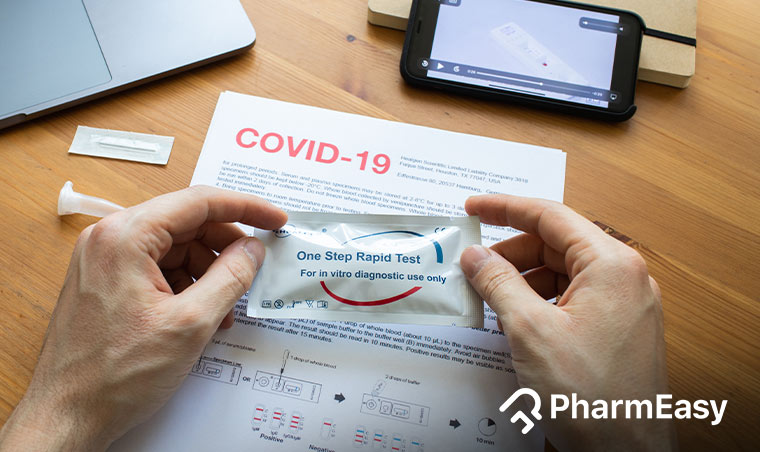ICMR Guidelines | COVID-19 Home Testing Kits Approved
By Dr. Nikita Toshi +2 more

Get,

to manage your symptom
Get your,


4 Cr+ families
benefitted

OTP sent to 9988776655



You’ve successfully subscribed to receive
doctor-approved tips on
Whatsapp

Get ready to feel your best.

Hi There,
Download the PharmEasy App now!!


Register to Avail the Offer
Send OTPBy continuing, you agree with our Privacy Policy and Terms and Conditions

Hi There,
Sign up on PharmEasy now!!
Trusted by 4 crore+ families

OTP sent to 9988776655



You have unlocked 25% off on medicines




Code: NU25
By Dr. Nikita Toshi +2 more
Table of Contents
Recently there has been another medical breakthrough in the fight against COVID-19. The Indian Council of Medical Research (ICMR) has approved a home Rapid Antigen testing (RAT) kit for COVID-19. According to the ICMR, the COVID-19 home test kit manufactured by Mylab Discovery Solutions Ltd, Pune, has been validated and approved. The ICMR has clearly stated that since the COVID-19 home test is a nasal swab test it should be conducted as per the instructions given by the manufacturer in the user manual.
The COVID-19 RAT test enables people to collect their nasal samples and test if they are COVID-19 positive. With the pandemic spreading like wildfire in many states of India, there is immense pressure on diagnostic labs conducting RT-PCR tests. Moreover, the RT-PCR test takes two to three days to give results which delay the start of treatment for positive patients. The ICMR has now approved the COVID-19 home test kit as it gives quick results in fifteen minutes. The guidelines that need to be followed while conducting the COVID-19 RAT test are given below.

The company manufacturing the COVID-19 home test kits promises to make millions of kits for India and that too at an inexpensive price. India has a huge population and regular testing through RT-PCR is not only impossible but also expensive. As a result, many avoid getting tested despite having symptoms. The self-testing kit being cheaper is accessible to a huge portion of the population who earlier refrained from getting tested.
The person using the COVID-19 home test kit must download MyLab’s AI-powered mobile app to get their reports as soon as possible. The home testing mobile app is available in the Google Play store and Apple store and must be downloaded by all users. The mobile app submits the result to ICMR immediately so that patients can get their reports and start treatment if found COVID-19 positive.
The mobile app is a comprehensive guide of the testing procedure and will provide a positive or negative test result to the patient. All users ‘MUST’ click a picture of the test strip after completing the test procedure with the same mobile phone which has been used for downloading the mobile app and user registration.
The home RAT test for COVID-19 is a significant step in our fight against COVID-19. Although less sensitive, it gives patients a sense of direction to start isolation and treatment as soon as found positive. Rapid antigen tests are also cheaper compared to RT-PCR and reduce the excessive pressure and the dependence on RT-PCR tests. But you should consciously follow the instructions given by both ICMR and the home testing kit company before conducting the test at home.
Disclaimer: The information provided here is for educational/awareness purposes only and is not intended to be a substitute for medical treatment by a healthcare professional and should not be relied upon to diagnose or treat any medical condition. The reader should consult a registered medical practitioner to determine the appropriateness of the information and before consuming any medication. PharmEasy does not provide any guarantee or warranty (express or implied) regarding the accuracy, adequacy, completeness, legality, reliability or usefulness of the information; and disclaims any liability arising thereof.
Links and product recommendations in the information provided here are advertisements of third-party products available on the website. PharmEasy does not make any representation on the accuracy or suitability of such products/services. Advertisements do not influence the editorial decisions or content. The information in this blog is subject to change without notice. The authors and administrators reserve the right to modify, add, or remove content without notification. It is your responsibility to review this disclaimer regularly for any changes.

Leave your comment...
Comments